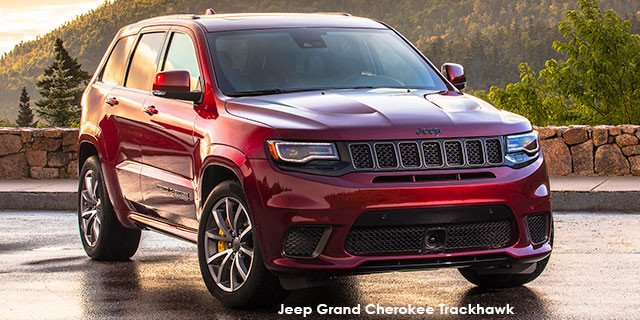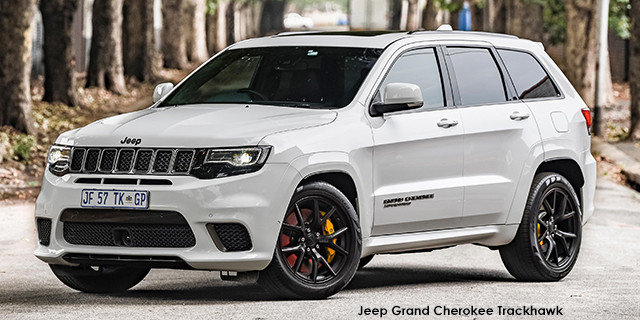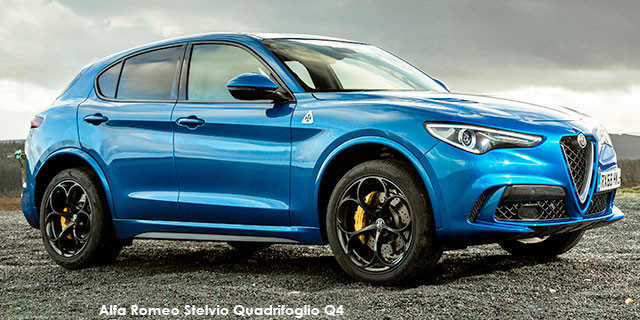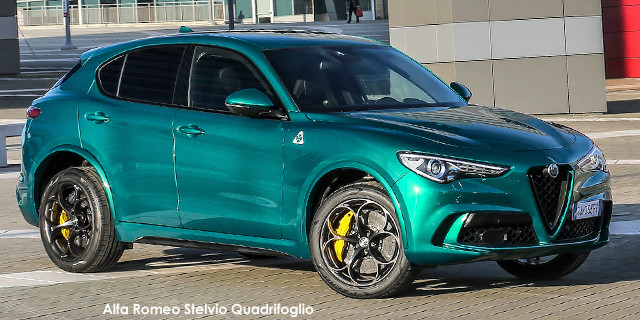
Built with gravity-defying pace in mind, just how different are these step-siblings? We test the Jeep Grand Cherokee Trackhawk and Alfa Romeo Stelvio Quadrifoglio...
When planning the most potent version of the current (fourth) generation Jeep Grand Cherokee, can there be any doubt the first order of business was just how much power FCA could shoehorn into this nine-year-old platform? In true American muscle-car fashion – and calling on the FCA Group-owned Mopar’s parts bin – all subsequent meetings surely dealt with what else was required to upgrade this family-friendly SUV to accommodate Chrysler’s “Hellcat” 6,2-litre supercharged Hemi V8.
Named after a World War Two fighter plane, the Hellcat features a 103,9 mm bore and 90,9 mm stroke to offer a capacity of 6 166 cm3. Fitted with a 2 380 cm3 IHI supercharger, in the hottest Grand Cherokee, this engine delivers 522 kW at 6 000 r/min and 868 N.m of torque at 4 800 r/min to all four wheels via a TorqueFlight eight-speed automatic transmission. If that all sounds like a mouthful, wait until the Trackhawk clears its throat…
Riding 25 mm lower than a standard model, there’s no mistaking the new range-topping Jeep when parked alongside its “Trail-rated” siblings. Bright yellow Brembo brake callipers and 20-inch alloy wheels are housed in flared arches, while extended side sills and additional intakes where foglamps are usually located complement a visual package bookended by a heavily sculpted and vented bonnet fore and a bespoke quad exhaust tailpipe arrangement aft.
Inside, the dated cabin is lifted via heated and ventilated Nappa-leather upholstery, a flat-bottomed steering wheel and updated instrumentation, including additional performance-related telemetry installed within the cluster and an 8,4-inch Uconnect infotainment system. Broadly spacious throughout, there’s an overriding sense of comfort within the fastest Jeep to date’s cabin. Thick carpeting, a premium sound system with a rear passenger (Blu-ray) entertainment system, a standard sunroof and generously cushioned front seats conspire against this vehicle’s naming strategy.
Another spanner in the Trackhawk’s lap-time ambitions is a recorded 2,4-tonne overall mass. Yet, via a severely taxed launch-control system, our Ivory Tri-coat-coloured test unit was able to blast from standstill to 100 km/h in just 4,22 seconds; Jeep claims a sub-12 second quarter-mile time for this vehicle. Complementing a baritone of V8 goodness under hard acceleration is a smile-inducing whine from the hard-working supercharger.
The Hellcat engine was never designed to accommodate an all-wheel-drive drivetrain and modifications to the Grand Cherokee’s underpinnings include updated transmission mapping, a strengthened rear driveshaft and a stronger rear axle. Torque is delivered to the rear wheels via aerospace-grade steel prop- and half-shafts.
Considering the forces involved, the 100-0 km/h stopping time is an impressive average of 2,97 seconds aided by massive 400 mm ventilated front discs and 350 mm solid units at the rear.
Not quite a one-trick pony, the Trackhawk’s independent front suspension and multilink rear setup incorporate Bilstein adaptive damping, while Jeep’s Quadra-Trac all-wheel-drive system – including an electronic limited-slip rear differential – can be configured through various driving modes. These include a 30:70, front to rear, torque split in track mode, a 35:65 sport mode or a 60:40-split towing setting and 50:50 snow mode. Alternatively, this intuitive system can be left to its own devices, distributing torque as required to maintain optimal traction. The 868 N.m Trackhawk offers a braked towing capacity of 2,9 tonnes.
In a vehicle this size, however, the penalty for carrying too much speed into a corner will always be understeer. Thankfully, with so much weight at play, these movements are predictable and largely countered via a well-considered stomp of the loud pedal once steering feel is recovered.
The levels of sensitivity of the transmission, stability control, adaptive damping and steering are configurable via the aforementioned touchscreen-based infotainment system.
Countering the unapologetic brashness of its American step-sibling, the altogether more sophisticated Stelvio package wears its Giulia-mimicking exterior panels like a tailored suit. Not only does it look more svelte compared with the Jeep but – thanks to the considered use of aluminium for panels like the doors, bonnet and fenders – the top-of-the-range Stelvio weighs some 580 kg less than the Trackhawk and it feels that way in nearly every application.
First sampled in our February 2018 issue, both the entry-level Stelvio Super and Quadrifoglio have clearly been engineered around a complete dynamic package. To the already head-turning shape of the standard car, the fastest version gains 20-inch alloy wheels in extended arches, revised front and rear bumpers (incorporating quad tailpipes) and a vented bonnet … and let’s not forget the brand’s famous four-leaf clover emblem on the front arches.
Inside, form-hugging front seats offer impressive lateral support while a relatively small, Alcantara-clad flat-bottom steering wheel adds a sense of purpose to the Quadrifoglio package. As with the Giulia, the selection of materials remains a mixed bag in modern Alfa Romeo products. Together with a neatly integrated (non-touchscreen) 8,8-inch infotainment display and special touches like the pistol grip transmission lever, fantastic-to-touch (aluminium) column-mounted transmission paddles and the start/stop button included on the steering wheel rim, Alfa’s first SUV feels unique compared with its mostly Germanic rivals.
If the Trackhawk’s Hemi engine is all-American, the Stelvio’s bi-turbocharged 2,9-litre V6 powertrain with its Ferrari F154 (V8) engine lineage, is as Italian as they come. Boasting 375 kW at 6 500 r/min with 600 N.m of torque from 2 500 to 5 500 r/min, performance is directed to all corners via a ZF-sourced eight-speed automatic transmission and Alfa Romeo’s Q4 all-wheel-drive system. Able to decouple three cylinders for improved efficiency under light load, at full taps up to 50% of available torque can be directed via a carbon-fibre driveshaft to the front axle as required.
Launched with the fanfare of a Nürburgring Nordschleife lap record for SUVs (now held by the Audi RS Q8), the Stelvio Quadrifoglio claimed the bragging rights in this group test by narrowly eclipsing the Jeep’s 0-100 km/h sprint time (and only after an unmitigated limp mode had self-rectified). However, the Trackhawk did register superior overtaking acceleration times compared with the Alfa. Adding further testament to the strength of the American car’s braking system is that little separated these two in terms of stopping performance on the day.
Widely lauded for their dynamic ability, modern Alfa Romeos offer a seat-of-your-pants driving style. Even in its tamest setting, the Stelvio Q feels alert and ready for action. This includes a level of brake pedal sensitivity that takes a bit of getting used to, as well as a sharp steering system that doesn’t offer much in the way of leisurely respite. Some will savour this setup, while others will want for a broader range of weightings based on which of the driving modes is selected. On this, race mode at least offers the option to adjust the Stelvio’s adaptive dampers into a more forgiving (for public roads) middle ground setting.
Unlike the Jeep that wants for a level of perspective before committing to a corner, the Alfa craves a sharp turn-in and early application of the throttle. In race mode, this also allows for a level of progressive, well-telegraphed playfulness that, in the Trackhawk, would have passengers assuming the brace position. In this setting, the bi-turbocharged V6 elicits a soundtrack to make its more illustrious Italian compatriots proud; just as the Jeep’s cold start bark could easily evoke a “hell, yeah!” from unsuspecting passersby.
The Jeep Grand Cherokee Trackhawk offers a claimed combined fuel consumption of 17,1 L/100 km but on the day of our fuel run, the planets aligned to return a more palatable – though never replicated during the test period – 15,8 L/100 km. Even with its 94-litre fuel tank, don’t count on seeing a range of more than 500 km, especially with all the requests for traffic light revs and races you’re likely to encounter along the way.
Combined with the aforementioned cylinder-deactivation technology, the Stelvio Quadrifoglio has a claimed combined fuel consumption of 9,0 L/100 km, although our fuel run figure suggested it’s closer to 11,0 L/100 km. A 64-litre fuel tank should realise a range closer to 600 km.
The deceptively large Alfa Romeo offers a measured luggage capacity of 368 litres compared with the Jeep’s 352 litres.
Included in the apex Grand Cherokee’s asking price is a bouquet of convenience and safety features. Some of the plastics and trim items don’t feel up to this price point but the standard equipment includes adaptive cruise control, lane-departure warning and a full house of airbags. Dual-zone climate control and smartphone pairing technologies complete the package.
The Stelvio, too, offers six airbags as well as autonomous braking, blind-spot monitoring and forward-collision warning. Included in its asking price are bi-xenon headlamps, dual-zone climate control, a comprehensive infotainment system and genuine carbon interior accents.
TEST SUMMARY
Originating from different sides of the pond and thus offering polar opposite personalities, the Jeep and Alfa Romeo share a parent company and – especially in our market – an outside-looking-in view when it comes to comparisons with their established rivals.
The Trackhawk represents a timely reminder of everything good (and comparatively below par) about the ageing fourth-generation Grand Cherokee ahead of the scheduled 2021 arrival of the all-new model. Broadly comfortable and impressively capable in its standard guise, some of the interior trim and adornments are showing their age. While we love the American market for its fervour towards displacement, in the fast-changing real world, models like the Trackhawk must surely be on the endangered species list.
The fastest Jeep is loud, thirsty, wallowy and doesn’t nearly live up to its track-focused name, but we love it for its lunacy, straight-line pace, ferocious bark and anti-establishment stance.
Like its Giulia stablemate, the Stelvio Quadrifoglio deserves all the praise and plaudits it has garnered thus far. Aimed predominantly at the enthusiast, the fastest Alfa Romeos don’t do “leisurely” well; instead, they always feel alert. Once let loose, there’s a welcome level of precision and poise that most rivals would struggle to match. The Stelvio manages to belie its weight by feeling – almost – as agile as a hatchback. Body roll is kept well in check and that Ferrari-derived engine is one of the best in the business.
ROAD TEST SCORE

|

|

|

|

|
Original article from Car
See Full Alfa Romeo Stelvio price and specs here















